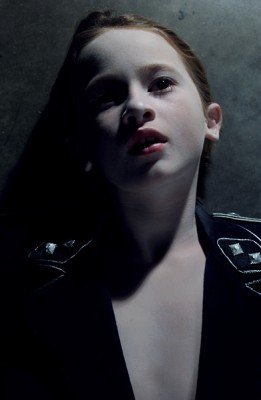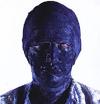Press and Media
San Francisco Chronicle – November 17, 2004
CHILDHOOD ISN'T WHAT IT USED TO BE. IN THE ARTS, IT'S DARK AND COMPLEX.
Gottfried Helnwein's work is on display at the Legion of Honor and at Modernism Inc.
Her lips are parted and colored a luscious deep red. The pancake makeup on her face gives off a marble-white glow. A jacket, adorned with braided gold epaulets at the shoulders, yawns open, exposing a wide expanse of skin down her chest. She appears to be about 8 years old.
There was a time, not so long ago, when the subject of Gottfried Helnwein's new, large-format digital prints at San Francisco's Modernism Gallery might have alarmed or even scandalized a viewer. Not anymore -- or at least not so reflexively...
Adults bring a trunkful of contradictory cultural baggage to any representations of children. That's what makes the work of Helnwein so powerful. In his show, "The Child," at the Legion of Honor, deformed infants and bandaged children stir feelings of pity, defiance and uneasiness about exploitation. There's an ambiguously disturbing painting of a girl aiming a gun into an open refrigerator and another of a bare-breasted mother and child surrounded by Aryan soldiers.
But the most haunting images, here and across town at Modernism, may be the ones of children who seem strangely oblivious to the adult gaze. Some of Helnwein's children peer right past the onlooker. Others sleep, dreaming of anything but us behind their silky eyelids. And some, like the enormous, half- shadowed "Head of a Child" at the Legion, see straight through us with cloudless, infinite blue eyes.

Childhood has become a boundless new frontier in the arts, a terrain of seemingly infinite magnitude, emotional density and thematic complexity. Audiences may find themselves disoriented and unnerved, as the conventional views of innocence, precociousness and predatory corruption give way to deeper vistas of childhood experience and meaning. In complicated, challenging and sometimes confounding ways, children occupy an increasingly large share of our collective imagination.
"As a culture in 2004, we're really of two unresolved minds about children," says Amy Jordan, director of Media and the Developing Child at the University of Pennsylvania's Annenberg School for Communication. "On the one hand, we see them as these innocent, vulnerable beings in need of our protection and government regulation -- from violence or Janet Jackson's breast on TV. On the other hand, we see them as every bit the equal of adults -- and not only as consumers. I think we carry around these dual views of children and childhood that are at odds with each other, and that gets played out in movies and television and books."
In "Birth," a confidently poised psychological thriller directed by Jonathan Glazer, a 10-year-old boy (Cameron Bright) falls in love with an adult woman (Nicole Kidman) and declares himself to be her dead husband reincarnated. The story unfolds in a frank, disarmingly unsensational way, as this placidly unshakable child presses his case and rattles the adult characters to the core. In one delicate and controversial scene, the boy climbs into a bathtub with Kidman while both are in the throes of his claim to be her character's husband.
What's striking here is not so much the implied sexuality of the scene but rather the watchful thrill Kidman conveys at the unknown. With her closely cropped hair and wide, swimming eyes, she's like a child herself, launched by grief and hope into a weightless wonderland of possibility, ungoverned by the gravitational laws of behavior. She's entered his child world of determined fantasy as much as he's entered hers.
For filmmaker Jonathan Caouette, his own turbulent childhood is a crucial component of the emotionally raw material in "Tarnation." Caouette stitches video footage of himself from age 11, the forlorn gay child of a mentally ill single mother, into a swirling, expressionistic autobiography about embracing and transcending early trauma.
What 11-year-old Jonathan soberly calls "testimony" to his video camera is in fact a kind of performance -- part true confession, part girlish vamping and part defiant role-playing of an avenging abused wife. In creating this documentary record in the first place and then working it into his adult film, Caouette captures an important truth about childhood. It is, often in quite conscious ways, a testing out and trying on of character, an earnest, improvisatory, orchestrated creation of a self.
Novelists as different as Jonathan Lethem ("The Fortress of Solitude") and Andrew Sean Greer ("The Confessions of Max Tivoli") explore the vividness and persistence of childhood as a means of understanding and ordering the world. The popular Lemony Snicket books, by San Francisco author Daniel Handler, turn the unbridled terrors and dark-side impulses of children into wry, Edward Goreyesque horror. Harry Potter's multivolume maturation, meanwhile, may be the most avidly attended rite of passage in modern literary annals.
Childhood stirs a range of responses from visual artists, from attentive wonderment to subversive black comedy. In a sweet-natured retrospective at the Asian Art Museum, Japanese printmaker Tetsuya Noda captures his own children in assorted domestic scenes from unguarded infancy to adolescence to the self- absorbed teenage years -- bathing, crying, posing in a mask, practicing a guitar alone.
Husband-and-wife photographers Davis & Davis use generic dime-store dolls and props to create their woozily colored "Childish Things" images that run from impish to teasing to sinister. Baby dolls tumble from windows and plunge perilously off their high chairs. In one panel of "The Kissers" diptych, a young boy and girl shyly experiment; in the other, with both plastic hands demurely tucked in their plastic pockets, the two boys nuzzle while the girl looks on. A selection of the photographs were on view recently at the Heather Marx Gallery; the "Childish Things" book is published by Santa Monica Press.
Choreographers and animated characters get into the children-are- everywhere act as well. The final piece on the recent Alonzo King's LINES Ballet program at the Yerba Buena Center for the Arts crystallized the eternal drama of child and parent into an exquisitely anguished pas de deux. Laurel Keen danced the mother in the "Ma" section of "Who Dressed You Like a Foreigner?" and Brett Conway was her offspring, splay-legged, terrified, determined to break free. The forces of nurture and release, connection and separation ran like high-tension wires between the two dancers.
In "The Incredibles," Pixar's new family action film, the story's retired superhero parents initially try to shield their children from their own genetic potency. Determined to live a normal suburban life, Bob and Helen Parr insist that their superspeedy son, Dash, not compete in sports at school and that their teenage daughter, Violet, keep her gifts hidden behind a flap of self-effacing hair. But when the family encounters a villain (who happens to be a kind of malevolent, unmatured child himself), parental ambivalence burns away. "You have more power than you realize," Helen tells Violet. With that, she releases her daughter's buried superchild and helps revitalize the Incredible clan in the process.
Children dramatize the essential human struggle between dependence and autonomy, community and individuality. They openly enact the eternal quest for identity that begins at birth and goes on driving adults even as society insists that grown-ups tamp it down and play their roles as responsible workers, parents and citizens. "The Incredibles" is about the difficulty of doing that, the gnawing sense of adult loss and capitulation. In a leitmotif image, the sagging, broad-shouldered frame of Mr. Incredible, a.k.a. Bob Parr, is squeezed inside an insurance office cubicle.
Children's freedom from all that is both exhilarating and threatening. Through history, cultures have tried in various ways to domesticate, deny, sentimentalize and sanitize childhood's tumultuous churn. Idealized by the ancient Greeks, children are "strangely absent from art" for centuries after the classical period, writes Joan Bel Geddes in "Childhood and Children: A Compendium of Customs, Superstitions, Theories, Profiles, and Facts." Again and again, into the Renaissance and beyond, the most frequently depicted children (the Christ child and baby John the Baptist) are represented as serious miniature adults.
It was only with the rise of compulsory education and restructuring of the family, in the 17th and 18th centuries, that children began to remain children beyond their earliest years. And even at that, as Dickens and others documented, many were thrust into the workplace -- as they are throughout the developing world today.
What University of Michigan art historian James Steward calls the "cult of the innocent child" is a relatively recent invention, a "banal, simplistic" product of the Victorian Age. "Before that," he says, "going back to the Renaissance, children were often depicted in ways that were far more nuanced and psychologically complex." Paintings of children and adolescents by such artists as Thomas Gainsborough and Joshua Reynolds held "layered references to sexuality," Steward says, "that the audience of the time would have easily understood."
Childhood, as the Annenberg Center's Jordan points out, has always been a "socially constructed" reality.
Freud's focus on the psychological weight of early-life experience and a Dr. Spock-fed study of developmental stages expanded the concept and importance of childhood in the 20th century. In the arts, children took on a new potency. Sweetheart Shirley Temple imagery gave way to depictions of children as moral (and immoral) agents ("Lord of the Flies"), sexual beings ("Lolita"), the conscience of a community ("E.T."), subversives ("South Park") and prevailing intellects (Lisa of "The Simpsons").
Steward sees in the work of photographer Sally Mann (known for nude studies of her own children) and filmmaker Larry Clark ("Kids") as efforts to "reclaim the complexity of childhood in a more honest way." A mighty new industry of children's media, meanwhile, created a flood of "constructive" and "positive" programming, from the excellent to the execrable.
Today, argues author Ellen Handler Spitz ("Inside Picture Books"), "the way children are represented is getting more and more polarized." She sees a stark ideological divide between diversity advocates who insist that every type of child and family be seen and a consumerist environment of uniform tests and standards that favors monochrome, cookie-cutter childhoods. "We're losing the unique and imaginative experience of what tasting the first few years of life ought to be," Spitz says.
Robert Zemeckis' new film, "The Polar Express," aims to capture that vividness even as it's slipping away. Childhood becomes a slender, magically radiant rail for a boy whose faith in Santa Claus -- and by extension in fantasy itself -- is trembling. He's swept away, with a trainful of other children, to recover it on a dream journey to the North Pole.
This Christmas fable has its saccharine qualities, but the much-discussed animation technique, which brings a sculpted, deeply shadowed dimension to a cartoon world, supplies a haunting undertow. In one inspired sequence, at once tense and lyrical, one of the children's train tickets flutters out the window and away from the speeding train. Curling past moonlit crags and treetops, it comes to rest in a still, snowy wood. Suddenly, out of nowhere, a pack of wolves appears and charges off down a steep ravine, the ticket carried off into the night on the animals' bristling fur.
The ticket is miraculously returned to the child in the end, and the movie's blessed journey resumes. But for adult viewers and prescient children alike, who know what's out there in the dark, those wolves don't disappear. They're always out there, the charging force and fury of real life. We ache for the boy and his fellow travelers on "The Polar Express," tuned for a few last measures to the fragile music of childhood.
Adults bring a trunkful of contradictory cultural baggage to any representations of children. That's what makes the work of Helnwein so powerful. In his show, "The Child," at the Legion of Honor, deformed infants and bandaged children stir feelings of pity, defiance and uneasiness about exploitation. There's an ambiguously disturbing painting of a girl aiming a gun into an open refrigerator and another of a bare-breasted mother and child surrounded by Aryan soldiers.
But the most haunting images, here and across town at Modernism, may be the ones of children who seem strangely oblivious to the adult gaze. Some of Helnwein's children peer right past the onlooker. Others sleep, dreaming of anything but us behind their silky eyelids. And some, like the enormous, half- shadowed "Head of a Child" at the Legion, see straight through us with cloudless, infinite blue eyes.
The more we see of childhood in the arts, paradoxically, the deeper its mysteries may become. It's the tunnel we all pass through, those early years of wandering toward the light as we dream ourselves up. It forms us; it makes us who we are. And once we've left the tunnel, we begin to forget, lose what we knew and felt back there and peer longingly behind us into its deep, plush darkness.
E-mail Steven Winn at swinn@sfchronicle.com.
Page E - 1
San Francisco Chronicle
go: www.sfgate.com
Printable version
go: Printable version
17. November 2004 San Francisco Chronicle Steven Winn


